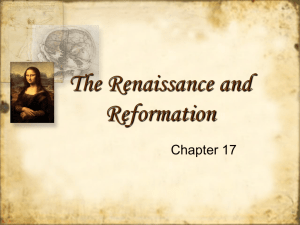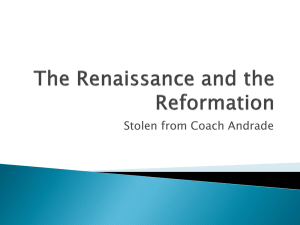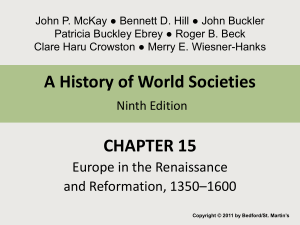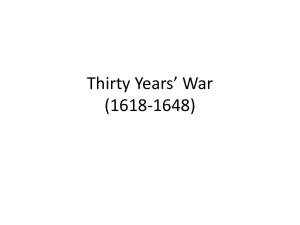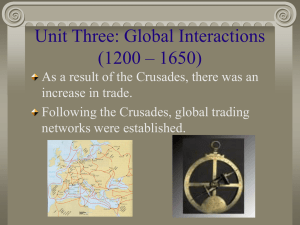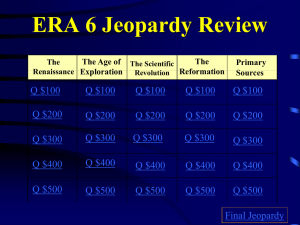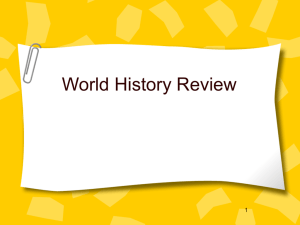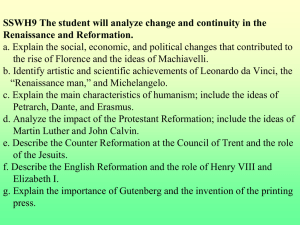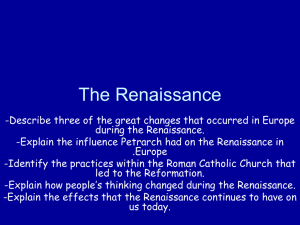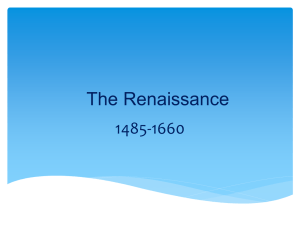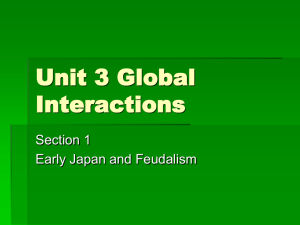Renaissance - Stratford High School
advertisement
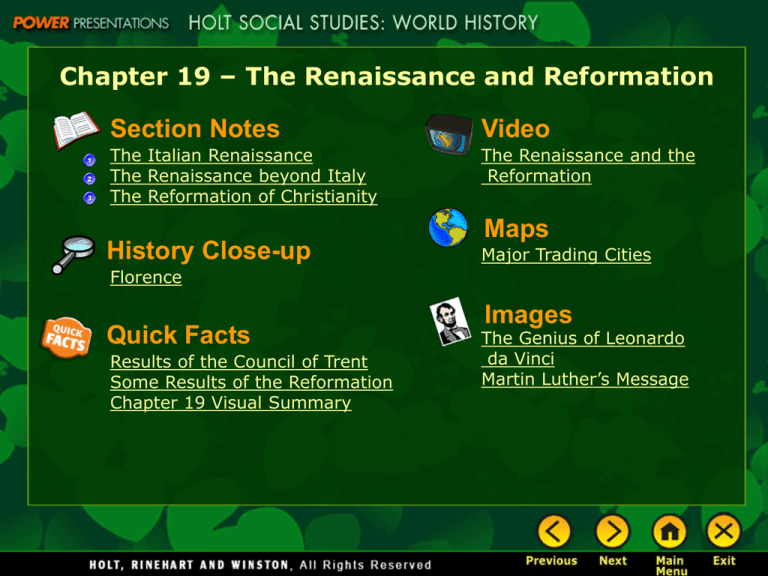
Chapter 19 – The Renaissance and Reformation Section Notes Video The Italian Renaissance The Renaissance beyond Italy The Reformation of Christianity The Renaissance and the Reformation History Close-up Maps Major Trading Cities Florence Quick Facts Results of the Council of Trent Some Results of the Reformation Chapter 19 Visual Summary Images The Genius of Leonardo da Vinci Martin Luther’s Message The Italian Renaissance The Big Idea The growth of wealthy trading cities in Italy led to a rebirth of the arts and learning called the Renaissance. Main Ideas • Increased trade with Asia brought wealth to Italian trade cities, leading to the Renaissance. • Italian writers and artists contributed great works during the Renaissance. Main Idea 1: Increased trade with Asia brought wealth to Italian trade cities, leading to the Renaissance. After the end of the Black Death, the economy of Europe began to grow again. Goods became available, people bought more, and trade increased. Trade with Asia • In the 1200s, the Mongols took over China. They made roads safe again, including the Silk Road, a trade route between Europe and China. • Traders and travelers began to use the routes again. One famous trader was Marco Polo, who traveled with his family. Some of their journeys went over the Silk Road. • When the Polos arrived in China, they met the Mongol emperor Kublai Khan. The Polos spent 20 years in Asia. • A writer helped Polo record his journey. Descriptions about Asia made Europeans curious, and they desired Asian goods. The Trading Cities of Italy • Four northern Italian cities became trading centers. – Florence – Genoa – Milan – Venice • The cities of Milan and Florence were manufacturing centers. Venice and Genoa were port cities on the Mediterranean Sea, where the goods and services flowed. • Milan produced weapons and silk. Florence was a center for weaving wool into cloth. Florence • Florence stands out as an example of the great trade and wealth coming into Italy. • Wool trade initially created wealth, but banking increased that wealth. – Bankers kept money for merchants all over Europe and made money by charging interest, a fee that lenders charge people who borrow money from them. • The Medici family were the greatest of the Florence bankers. – Cosimo Medici wanted Florence to be the most beautiful city in the world. – He also valued education and built libraries and collected books. • The love of art and education was a key feature of a time we call the Renaissance, which means “rebirth.” Main Idea 2: Italian writers and artists contributed great works during the Renaissance. • During the Middle Ages, people were devoted to religious study. By the 1300s, scholars began to study subjects such as history, literature, public speaking, and art. • These subjects were called the humanities, and they led to the thinking and learning known as humanism. – Humanism is a way of thinking and learning that stresses the importance of human abilities and actions. Rediscovering the Past • The popularity of the humanities was due to a new interest in ancient history. • During the 1300s, when the Turks conquered much of the Byzantine Empire, scholars fled to Europe and took great works of literature with them. • Many of the works were ancient classical writings, such as works by Greek thinkers. • Italian scholars wanted to revive subjects that the Greeks and Romans had studied. • Other sources of inspiration were Roman ruins and fine classical statues. Italian Writers: Dante and Machiavelli • Dante Alighieri was a politician and poet. Dante wrote in Italian, the common language of the people. – Before Dante, most medieval writers had written in Latin. • Niccolò Machiavelli wrote The Prince. He was also a politician, and his book told leaders how to rule. – Told politicians to focus on the “here and now,” not on theories Italian Art and Artists • During the Renaissance, Italian artists created some of the most beautiful paintings and sculptures in the world. • New techniques, like perspective, made their work come alive. – Perspective is a way of showing depth on a flat surface. Great Artists There were several great Italian Renaissance artists, but two stand out. – Michelangelo was one of the great Italian artists. He was known as a master. He not only painted portraits but also designed buildings, wrote poetry, and painted murals on the ceiling of the Sistine Chapel in the Vatican. – Leonardo da Vinci was the true genius of the Renaissance. He was a great painter, sculptor, architect, inventor, and engineer. He studied anatomy, the structure of human bodies, to make his paintings more real. His Mona Lisa portrait is one example. The Renaissance beyond Italy The Big Idea The Renaissance spread far beyond Italy, and as it spread, it changed. Main Ideas • During the Renaissance, advances in science and education were made. • New ideas from the Renaissance spread across Europe through the development of paper, printing, and new universities. Main Idea 1: During the Renaissance, advances in science and education were made. • Some Renaissance scientists thought mathematics could help them understand the universe. – They created many math symbols that we still use today. • Engineers and architects used new math formulas to strengthen buildings. • Other scientists studied astronomy to learn more about the sun, stars, and planets. – They learned that the earth moves around the sun. • Students began to study the humanities as well as religious subjects. Main Idea 2: New ideas from the Renaissance spread across Europe through the development of paper, printing, and new universities. • Johannes Gutenberg, a German man living in the mid-1400s, developed a printing press with movable type. He printed the Bible in 1456. More people learned to read as books became more readily available. • Students from around Europe traveled to Italy to study at the universities. • New universities began to open in France, Germany, and the Netherlands. • Women from noble families were often educated at home. They then married nobles from around Europe and spread the Renaissance ideas to their husbands’ lands. The Northern Renaissance • Northern scholars focused on the history of Christianity. The resulting combination of humanist and religious ideas is called Christian humanism. • Northern scholars came to feel the church was corrupt and did not follow the teachings of Jesus. They called for reform. Art • Northern artists painted in a more realistic style and painted more daily-life subjects. • Albrecht Dürer was an artist from Germany who was most famous for his prints. – A print is a work of art reproduced from an original. – Studied anatomy so he could paint people more realistically Literature beyond Italy • Writers in other countries besides Italy also included Renaissance ideas in their work. They wrote in their own languages. • Miguel de Cervantes was a Spanish writer who wrote Don Quixote. • William Shakespeare wrote plays and poetry and is considered the greatest writer in the English language. The Protestant Reformation The Big Idea Efforts to reform the Roman Catholic Church led to changes in society and the creation of new churches. Main Ideas • Reformers called for change in the Catholic Church, but some broke away to form new churches. • The Catholic Reformation was an attempt to reform the church from within. • The political impact of the Reformation included religious wars and social change. Main Idea 1: Reformers called for change in the Catholic Church, but some broke away to form new churches. • By the late Renaissance, people had begun to complain about problems in the Catholic Church. • They called on its leaders to end corruption and focus on religion. • Their calls led to a reform movement against the Roman Catholic Church called the Reformation. Unpopular Church Practices • People felt that the clergy and the pope had become too political. • The way the church raised money was also considered unfair. The sale of indulgences was unpopular. – An indulgence was a document given by the pope that excused a person from penalties for sins he or she had committed. – The idea that the church was letting people buy their way into heaven made Christians angry. • These unpopular practices weakened the church, and people began calling for reform. Martin Luther • Martin Luther nailed a list of complaints to the door of a church in Wittenberg. This list was called the Ninety-five Theses. – The printing press allowed this list to be spread to neighboring states. • Luther thought that anyone could have a direct relationship with God. • He did not believe that priests had to speak to God for the people. • Beliefs should be based on the Bible, not interpreted by priests or the pope. • Luther translated the Bible into German so that Europeans could read it for the first time. Other Reformers • William Tyndale believed everyone should be able to read and interpret the Bible. He translated the Bible into English, and the Catholic authorities had him executed. • John Calvin believed that God knew who would be saved even before they were born. This is called predestination. Nothing that people did during their lives would change God’s plan, but it was important to live a good life and obey God’s laws. • Henry VIII wanted to leave his marriage. The pope refused Henry’s request, so he left the Catholic Church and created his own church. – The Church of England, or Anglican Church, was much like the Catholic Church, but it opened the door for other churches to form. Main Idea 2: The Catholic Reformation was an attempt to reform the church from within. • Protestantism spread in the later 1500s and 1600s. Catholic leaders responded to stop this spread. • The effort to reform the Catholic Church from within is called the Catholic Reformation, or Counter-Reformation. The Growth of Roman Catholic Spain • In 1492 the king and queen defeated the last Muslim forces in Spain. • Muslims and Jews were forced to convert to Catholicism. • The Spanish Inquisition was organized to seek out and punish Muslims and Jews who had converted but secretly kept their old beliefs. • The Catholic Church was ruthless in carrying out the Inquisition and later sought out Protestants. • The Catholics had very little opposition left in Spain. New Religious Orders • In some parts of Europe, Catholic leaders responded to Protestant criticism by forming new religious orders, or communities. • The first new order in Spain was created by Ignatius of Loyola. • The order was called the Society of Jesus, or the Jesuits. • The Jesuits were a religious order created to serve the pope and the church. • Jesuits were trained to be as disciplined as soldiers in their religious duties. • By teaching people about Catholic ideas, Jesuits hoped to turn people against Protestantism. The Council of Trent • Catholic leaders met together to discuss more ways to reform the Catholic Church. This meeting was known as the Council of Trent. • The council restated the importance of the clergy in interpreting the Bible. • The council ordered the bishops to live in the areas where their churches were located. • The council officially rejected the ideas of the Protestant leaders. • The pope created religious courts to punish Protestants found in Italy. Catholic Missionaries • Missionaries were people whose goal was to take Catholic teachings around the world. • Many of the new Catholic missionaries were Jesuits. These priests went to Africa, Asia, and America. • One of the most important missionaries was a Jesuit named Francis Xavier, who took Catholicism to India and Japan. • Missionaries baptized millions of people, and through their work the effects of the Catholic Reformation reached far beyond Europe. Main Idea 3: The political impact of the Reformation included religious wars and social change. • In Spain nearly everyone was still Catholic. • In northern countries people were mostly Protestant. • The Holy Roman Empire was a patchwork of different kingdoms, some Protestant and some Catholic. • These divisions led to political conflicts. Religious Wars in France • Protestants in France were called Huguenots. • The Huguenots and the Catholics began a war when the Catholic king banned all Protestant religions. – Violence began in 1562 and did not end until 1598. • Fighting was ended by the Edict of Nantes, which granted religious freedom to the Protestants in France, except in Paris and a few other cities. Religious Wars in the Holy Roman Empire • King of Bohemia forced everyone in the kingdom to become Catholic. • Protestants rose up in revolt in 1618. • This led to the Thirty Years’ War. • The war grew, and both sides called on other countries to come to their aid. • After 30 years of fighting, an agreement was reached—The Treaty of Westphalia. – It allowed rulers to decide whether their countries would be Catholic or Protestant. – The states of Germany became independent with no single rule, independent of the Holy Roman Empire. Social Changes • Through the Protestant Church, people began to make decisions about their churches. Now that they had that power, they also wanted political power. • Local towns began to govern themselves, and the national government had to share power. • The sharing of power between local governments and a strong central government is called federalism. • On an individual level, people began to think more for themselves and to investigate on their own.
